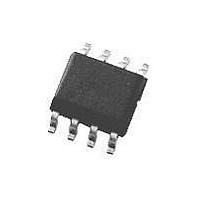LP2951ACM-3.3 National Semiconductor, LP2951ACM-3.3 Datasheet - Page 6

LP2951ACM-3.3
Manufacturer Part Number
LP2951ACM-3.3
Description
Linear Voltage Regulator IC
Manufacturer
National Semiconductor
Specifications of LP2951ACM-3.3
Dropout Voltage Vdo
380mV
No. Of Pins
8
Output Current
0.1A
Peak Reflow Compatible (260 C)
No
Output Voltage
3.3V
Output Voltage Max
3.3V
Supply Voltage Max
30V
Leaded Process Compatible
No
Lead Free Status / RoHS Status
Contains lead / RoHS non-compliant
Available stocks
Company
Part Number
Manufacturer
Quantity
Price
Company:
Part Number:
LP2951ACM-3.3
Manufacturer:
NS
Quantity:
4 795
Part Number:
LP2951ACM-3.3
Manufacturer:
TI/德州仪器
Quantity:
20 000
Company:
Part Number:
LP2951ACM-3.3/NOPB
Manufacturer:
TI
Quantity:
15 000
www.national.com
Shutdown Input
Shutdown Pin Input
Current
Regulator Output
Current in Shutdown
Electrical Characteristics
Note 1: Absolute Maximum Ratings are limits beyond which damage to the device may occur. Operating Ratings are conditions under which operation of the device
is guaranteed. Operating Ratings do not imply guaranteed performance limits. For guaranteed performance limits and associated test conditions, see the Electrical
Characteristics tables.
Note 2: Unless otherwise specified all limits guaranteed for V
Limits appearing in boldface type apply over the entire junction temperature range for operation. Limits appearing in normal type apply for T
conditions for the 8-pin versions are FEEDBACK tied to V
Note 3: Guaranteed and 100% production tested.
Note 4: Guaranteed but not 100% production tested. These limits are not used to calculate outgoing AQL levels.
Note 5: Dropout Voltage is defined as the input to output differential at which the output voltage drops 100 mV below its nominal value measured at 1V differential.
At very low values of programmed output voltage, the minimum input supply voltage of 2V (2.3V over temperature) must be taken into account.
Note 6: Comparator thresholds are expressed in terms of a voltage differential at the Feedback terminal below the nominal reference voltage measured at
V
For example, at a programmed output voltage of 5V, the Error output is guaranteed to go low when the output drops by 95 mV x 5V/1.235V = 384 mV.
Thresholds remain constant as a percent of V
Note 7: V
Note 8: The junction-to-ambient thermal resistances are as follows: 180˚C/W and 160˚C/W for the TO-92 package with 0.40 inch and 0.25 inch leads to the printed
circuit board (PCB) respectively, 105˚C/W for the molded plastic DIP (N), 130˚C/W for the ceramic DIP (J), 160˚C/W for the molded plastic SOP (M), 200˚C/W for the
molded plastic MSOP (MM), and 160˚C/W for the metal can package (H). The above thermal resistances for the N, J, M, and MM packages apply when the package
is soldered directly to the PCB. Junction-to-case thermal resistance for the H package is 20˚C/W. Junction-to-case thermal resistance for the TO-252 package is
5.4˚C/W.
Note 9: May exceed input supply voltage.
Note 10: When used in dual-supply systems where the output terminal sees loads returned to a negative supply, the output voltage should be diode-clamped to
ground.
Note 11: V
Note 12: Output or reference voltage temperature coefficient is defined as the worst case voltage change divided by the total temperature range.
Note 13: Thermal regulation is defined as the change in output voltage at a time T after a change in power dissipation is applied, excluding load or line regulation
effects. Specifications are for a 50 mA load pulse at V
Note 14: Regulation is measured at constant junction temperature, using pulse testing with a low duty cycle. Changes in output voltage due to heating effects are
covered under the specification for thermal regulation.
Note 15: Line regulation for the LP2951 is tested at 150˚C for I
Performance Characteristics for line regulation versus temperature and load current.
Note 16: A Military RETS specification is available on request. At time of printing, the LP2951 RETS specification complied with the boldface limits in this column.
The LP2951H, WG, or J may also be procured as Standard Military Drawing Spec # 5962-3870501MGA, MXA, or MPA.
Note 17: All LP2950 devices have the nominal output voltage coded as the last two digits of the part number. In the LP2951 products, the 3.0V and 3.3V versions
are designated by the last two digits, but the 5V version is denoted with no code at this location of the part number (refer to ordering information table).
Typical Performance Characteristics
Quiescent Current
in
= (V
Parameter
O
NOM + 1)V. To express these thresholds in terms of output voltage change, multiply by the error amplifier gain = V
ref
shutdown
V
out
(V
2V, V
in
− 1V), 2.3V
in
V
V
(Note 11)
shutdown
shutdown
30V, V
DS008546-27
Conditions
out
= 2.4V
= 30V
(Note 2)
V
= 0, Feedback pin tied to V
in
out
30V, 100 µA
as V
out
IN
(Note 2) (Continued)
Dropout Characteristics
= 30V (1.25W pulse) for T = 10 ms.
is varied, with the dropout warning occurring at typically 5% below nominal, 7.5% guaranteed.
TAP
I
, OUTPUT tied to SENSE, and V
Typ
IN
L
L
450
30
3
= 1 mA. For I
= (V
100 mA, T
ONOM
TAP
LP2951
(Notes 3, 16)
.
Tested
Limit
+ 1)V, I
100
600
750
50
10
20
J
L
= 100 µA and T
T
6
JMAX
L
= 100 µA and C
.
Typ
450
30
3
DS008546-28
J
= 125˚C, line regulation is guaranteed by design to 0.2%. See Typical
SHUTDOWN
LP2950AC-XX
LP2951AC-XX
(Note 3)
Tested
Limit
600
50
10
L
= 1 µF for 5V versions and 2.2 µF for 3V and 3.3V versions.
0.8V.
(Note 4)
Design
Limit
100
750
20
Input Current
Typ
450
30
3
out
/V
LP2950C-XX
LP2951C-XX
(Note 3)
ref
Tested
Limit
600
50
10
= (R1 + R2)/R2.
A
= T
(Note 4)
Design
J
Limit
100
750
= 25˚C. Additional
20
DS008546-29
µA max
µA max
µA max
µA max
µA max
µA max
Units











